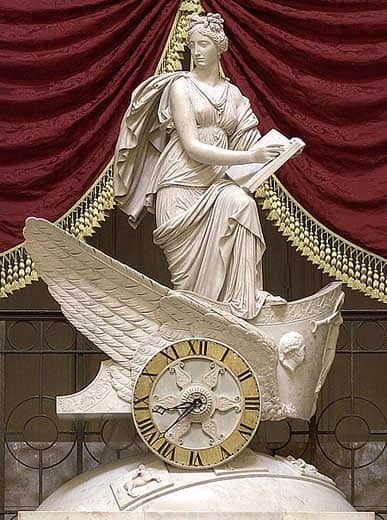
A Faith Deeply Rooted in History
Catholicism is a deeply unique religion. Something that makes the Catholic faith particularly unique is the claim of its Founder: “I am the way, the truth, and the life.” Unlike the founders of other religious traditions, Jesus Christ undoubtedly claims that not only is His way the path to salvation, but literally He is the way to salvation. Christ entered into the world in a particular time, place, and culture: born in first-century Judea, governed at the time by the Roman Empire, Jesus entered into human history in “the fullness of time” (Galatians 4:4), when the world was ripe for His saving intervention. His entrance into human history follows centuries of preparation, anticipation, and longing: all of the history of the nation of Israel (and Judah), and indeed the entire human race, is anticipating His arrival on the scene.
Therefore, the Catholic faith is deeply rooted in world history. It is a radically historical religion, one founded in real events, people, and places. The Gospels tell us that Jesus is the son of Mary and the foster son of Joseph, which are reliable facts that we can trust as historical fact, albeit always having a deeper spiritual truth. Indeed, the Church tells us of the various “senses” of Scripture: beginning with the historical or literal sense, and moving on to the deeper spiritual, moral, and anagogical senses. The literal or historical sense begins with the question of: of whom and what does this Scripture passage speak? Moving on from there, what is the deeper meaning? When we read of the journey of ancient Israel and Judah in the Old Testament, we understand this to be the literal sense: Israel and Judah are two ancient kingdoms, originally united under one kingship, founded by the patriarchs Abraham, Isaac, and Jacob, who established their residence in ancient Palestine over a thousand years before Jesus Christ. We know from archaeology that ancient Israel and Judah truly existed. The remains of the Western Wall of the Second Temple of Jerusalem, which remains to the present day, provides obvious evidence of the ancient kingdoms’ reality.
Modern scholars often attempt to reduce the “religiosity” of Jesus Christ by removing the miraculous and Divine aspects of His life and ministry. Rather than believing Him to be the incarnate Son of God, Joseph is regarded as his literal father. Rather than affirm His miraculous multiplication of the loaves to feed thousands of people, modern scholars may argue that Jesus merely “inspires” others to share what they have. While this, in itself, would certainly be a positive development, it nevertheless removes the Divine reality from Jesus Christ and His ministry. This attempt to undermine the Divinity of Christ often takes form in another way: an attempt to dismiss the Old Testament as unreliable history, as a “myth” created by ancient Israelities (and by Christians) to create a historical identity for the Jewish people and for their successor – the Catholic Church.
Catholicism must be rooted in history. Just as the Catholic Church is a real and visible reality – a Church with deeply rich history, full of immense drama and remarkable figures – its predecessor in ancient Israel and Judah must likewise be real. Kings David and Solomon, even Abraham and Moses, and indeed the Prophets, including Jonah, must be historical realities. If we know that Jesus Christ is real, then His predecessors in the Old Testament must be real as well. Indeed, Jesus specifically identifies Himself with the Prophet Jonah (who is, incidentally, the only Prophet He personally references by name). He is also described as Son of David, being a descendent of the great King. If Christ truly is the Savior of the world, then those who preceded Him lived as well.
The Books of Tobit and Isaiah offer us a glimpse into the reliability of the Bible, as offering religious truth as well as facts of human history. Tobit – which is included in the Catholic Bible, but typically not included in Protestant versions of Scripture – offers us insight into the exile of the northern kingdom of Israel following its conquest by Assyria in 722 BC. Tobit, a righteous northern Israelite who strives diligently to live the faith amidst exile, gives us important details into the Assyrian government. Tobit is an essential part of the Old Testament: he proves to us that the Assyrian conquest of Israel in 722 BC is a historical event, and likewise that many Israelites survived the conquest and lived in exile in Assyria afterwards. Tobit initially enjoys the respect of the King of Assyria, Shalmane’ser, but soon endures persecution under his son, Sennach’erib: “And if Sennach′erib the king put to death any who came fleeing from Judea, I buried them secretly. For in his anger he put many to death. When the bodies were sought by the king, they were not found. Then one of the men of Nin′eveh went and informed the king about me, that I was burying them; so I hid myself. When I learned that I was being searched for, to be put to death, I left home in fear. Then all my property was confiscated and nothing was left to me except my wife Anna and my son Tobi′as” (Tobit 1:18-20). In short, Tobit tells us that Sennach’erib is killed by his own two sons – a terrible fate for a terrible king.
The Book of Isaiah likewise provides us with the same information: following the Assyrian siege of Jerusalem in 701 BC, after the prayer of the righteous King of Judah, Hezekiah, an angel of God slays 185,000 Assyrian soldiers, sparing Jerusalem from destruction: “And the angel of the LORD went forth, and slew a hundred and eighty-five thousand in the camp of the Assyrians; and when men arose early in the morning, behold, these were all dead bodies” (Isaiah 37:36). Naturally, the Assyrian army retreats in utter defeat, with the wicked King of Assyria only to face further judgment. Isaiah continues: “Then Sennach’erib king of Assyria departed, and went home and dwelt at Nin’eveh. And as he was worshipping his god, Adram’melech and Share’zer, his sons, slew him with the sword, and escaped into the land of Ar’arat. And E’sar-had’don his son reigned in his stead” (Isaiah 37:37-38).
Notice the obvious similarity in what both Tobit and Isaiah tell us: King Sennacherib, an unrighteous King of Assyria, is assassinated by his own sons. Both Tobit and Isaiah suggest no reason to doubt the historicity of this event, telling us this information like it is reliable history. Furthermore, they offer information about the same event from differing perspectives: Tobit from the viewpoint of the northern Israelites living in exile in Assyria, and Isaiah from the viewpoint of the southern kingdom of Judah, facing an aggressive Assyria following its conquest of Israel. This may initially not seem like vital information, but it plays a major role in showing us the historicity of Sacred Scripture.
Something that makes the Catholic Church is its perseverance throughout the ages: nearly two-thousand years after the coming of her Founder, the Church endures. No one can deny the reality of the Church, and her remarkable ability to endure the ups and downs of history. The Church is the New Israel and Judah, having inherited so much of her treasures of faith and Scriptures from the Chosen People. We can trust that Israel and Judah, and the Old Testament, are reliable people, places, and events. Tobit and Isaiah provide us small, yet deeply significant, proof of this.


Excellent article with concise, brief, yet compelling summation. Reminds me why as a Biblical school graduate, I loved the study and prompts me to continue with catechetical study and proclaim the Word through facilitation of Bible study at my parish.
This is a well written article that does a good job succinctly outlining the historical foundation of our Church. Obviously well researched, the author managed to relay the importance of our history in a concise, easily readable style. If this is typical of St. John Vianney Lay division articles, I am very impressed.